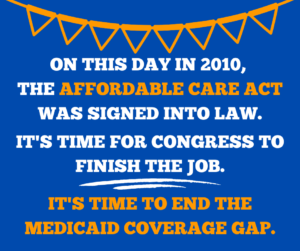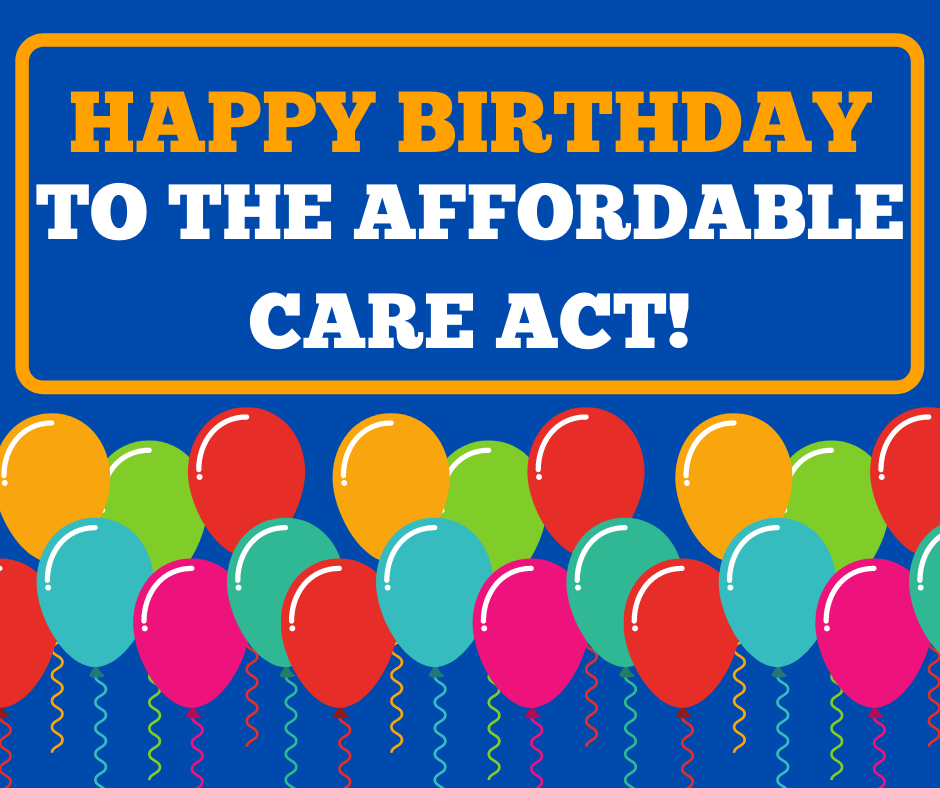- Like
- Digg
- Del
- Tumblr
- VKontakte
- Buffer
- Love This
- Odnoklassniki
- Meneame
- Blogger
- Amazon
- Yahoo Mail
- Gmail
- AOL
- Newsvine
- HackerNews
- Evernote
- MySpace
- Mail.ru
- Viadeo
- Line
- Comments
- Yummly
- SMS
- Viber
- Telegram
- Subscribe
- Skype
- Facebook Messenger
- Kakao
- LiveJournal
- Yammer
- Edgar
- Fintel
- Mix
- Instapaper
- Copy Link
 Twelve years ago, March 23, 2010, the Affordable Care Act was passed. Since then, many of us have been working hard to defend it from countless attacks from Congress, the courts and state legislators. The ACA stands as a pillar of our healthcare system, covering tens of millions and making healthcare better for well over one hundred million thanks to provisions like ending gender discrimination, discrimination against people with pre-existing conditions and arbitrary limits and caps on coverage which used to make healthcare inaccessible even for people who already had insurance. Here are some amazing data points I wanted to share.
Twelve years ago, March 23, 2010, the Affordable Care Act was passed. Since then, many of us have been working hard to defend it from countless attacks from Congress, the courts and state legislators. The ACA stands as a pillar of our healthcare system, covering tens of millions and making healthcare better for well over one hundred million thanks to provisions like ending gender discrimination, discrimination against people with pre-existing conditions and arbitrary limits and caps on coverage which used to make healthcare inaccessible even for people who already had insurance. Here are some amazing data points I wanted to share.
Today, over 30 million people, a record number, have coverage under the ACA’s provisions through either private health insurance or Medicaid. Over 130 million people have gained protections from discrimination against pre-existing conditions and now have freedom from arbitrary caps or limits on coverage.
The ACA has brought the number of uninsured people in the United States to historic lows.
- Between 2010, the year ACA passed, and 2016, the number of nonelderly uninsured adults decreased by 41%, falling from 48.2 million to 28.2 million.
- The number of uninsured people has fallen in all 50 states and the District of Columbia since the implementation of the ACA, with states that expanded Medicaid experiencing the largest reduction in their uninsured rate.
- California, Kentucky, New York, Oregon, Rhode Island, Washington, and West Virginia have reduced their uninsured rate by at least half from 2013 to 2019 through enrollment in Marketplace coverage and expansion of Medicaid to adult populations.
- Over 14.5 million people have signed up for Affordable Care Act Marketplace coverage for 2022. That’s a 21% increase over last year with Florida, Texas, Georgia, California and North Carolina seeing the biggest increases. See map here.
The COVID 19 pandemic laid bare critical shortcomings in our health care and health insurance systems and increased demand for ACA and Medicaid over the last year. Elected officials reacted with rescue packages and state policies to ensure that more people could access the health care they need to stay healthy and protect their families. In 2022, a record number of people enrolled in ACA’s marketplace coverage thanks to extended enrollment periods and discounts on coverage in President Biden’s American Rescue Plan Act (ARPA).
- ARPA guarantees coverage that health care costs will be less than 8.5 % of income saving average Americans $2400 annually on premiums. See state fact sheets here.
- ARPA also created new incentives for states that have not already expanded Medicaid to take up the expansion and to make improvements in the existing Medicaid program through enhanced support for HBCS (Home Based and Community Services) and extended postpartum care for new mothers.
- Under Biden’s Public Health Emergency (PHE) policy, states were required to ensure continuous enrollment in Medicaid so that the lowest income families who often work in jobs that don’t offer affordable insurance would have access to healthcare. Medicaid has been a critical resource in responding to all kinds of public health crises, from natural disasters and the 9/11 attacks to the pandemic.
- An additional 8.9 million adults gained Medicaid in 49 states and DC (doesn’t include Arizona). In addition 4.3 million children gained coverage under Medicaid/CHIP.
- Research shows that states that expanded Medicaid under the ACA are enjoying stronger income growth than those who did not, including the 12 states that have so far refused to close the Medicaid coverage gap because of political objections to the law.
The ACA and ARPA made big improvements to health care affordability and access, but we’re not done. Some improvements made over the past two years in response to the public health crisis created by COVID will expire unless Congress takes future action to make them permanent. Other improvements to health care, like making prescription drugs more affordable through negotiations in Medicare, enjoy tremendous public support and are long overdue.
President Biden and the new Congress must take action in the coming months to ensure the continuation of coverage and affordability, to lower drug prices, and to strengthen Medicaid and Medicare for the future so that everyone in America has equitable access to the quality affordable healthcare they need. They must pass a package that:
- Stops premium increases for millions by making permanent the ARPA increased premium assistance that will expire in October 2022.
- Closes the Medicaid coverage gap in 12 states where millions of people can’t get coverage because of political gridlock and prevents the expiration of the MOE (Maintenance of Effort) provisions under COVID relief that have helped 12 million more people get coverage.
- Lowers drug prices through Medicare negotiations so that drug corporations can longer use their monopoly control over prices to gouge consumers and patients.
- Limit out of pocket costs on prescriptions for seniors, limit the cost of insulin to $35 a month for everyone and stop drug corporations from raising the price of medicines faster than inflation.
Over the past 12 years, more and more people have gained affordable coverage under the ACA, providing them access to preventive and acute care and helping improve the economic security of countless families. Let’s celebrate these successes, and keep working to bridge coverage gaps, so that everyone has the option of affordable health care coverage.
Tell Your Members of Congress It’s Time To Finish the Job by
Closing the Medicaid Coverage Gap & Making Improved Affordability Permanent!

